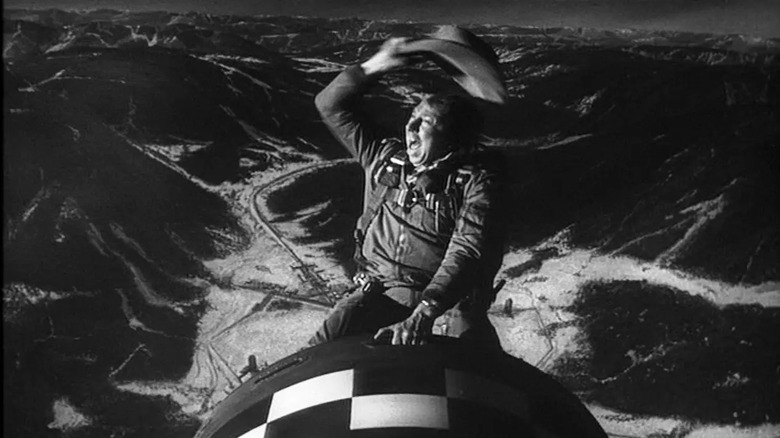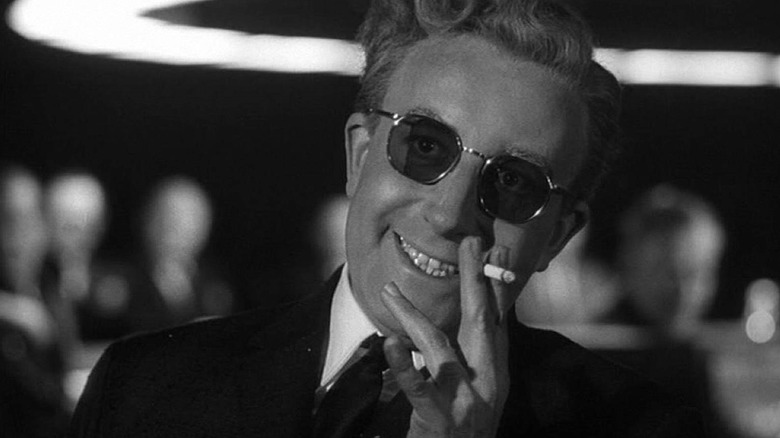Casting Dr. Strangelove's Major Kong Was A Constant Headache For Stanley Kubrick
When one thinks of Stanley Kubrick's 1964 Cold War satire "Dr. Strangelove or: How I Learned to Stop Worrying and Love the Bomb," the most iconic image that comes to mind is that of a hollering Slim Pickens straddling a descending hydrogen bomb. The journey to that image was a royal pain for the celebrated filmmaker.
"Strangelove" co-writer Terry Southern penned a memoir piece titled "Strangelove Outtake; Notes from the War Room," originally published in Grand Street magazine in 1994. He describes the pressure that Kubrick was under to employ Peter Sellers in multiple roles, which the Columbia suits had determined was the sole reason for the success of "Lolita" (it wasn't). So Kubrick agreed to cast Sellers in "at least four major roles," three of which made the final cut: Group Captain Lionel Mandrake, President Merkin Muffley, and the titular Doctor Strangelove.
The fourth role was Major Kong, who commands a bomber ordered to commence an attack flight on the USSR. There's really no way to recall the flight or prevent its nuclear payload from meeting its Soviet target. But Sellers wasn't confident about the Texan accent required for Kong, going so far as to voice his concerns in a telegram to Kubrick. Southern quotes the telegram:
Dear Stanley:
I am so very sorry to tell you that I am having serious difficulty
with the various roles. Now hear this: there is no way, repeat,
no way, I can play the Texas pilot, 'Major King- Kong.' I have
a complete block against that accent. Letter from Okin [his agent]
follows. Please forgive.
Peter S.
The Texan-born Southern went so far as recording Kong's lines on tape for Sellers, who only recorded a day's worth of footage inside the B-52 scene setting before hitting Kubrick with another type of bomb entirely.
No fighting in the war room
Southern continues in his recollection of the "Dr. Strangelove" shoot, stating that the production manager met with Kubrick with bad news, just a day after Sellers shot his first few Kong scenes: Sellers took a bad fall and injured his ankle — which made it impossible for him to film in the cramped space of the B-52. Kubrick negotiated a location shift, moving Kong to the more spacious area where the bay doors of the plane would open. No dice: Sellers slipped on a ladder during shooting and exacerbated his ankle injury. He would have to be replaced for the role of Kong.
Vincent LoBrutto's book "Stanley Kubrick: A Biography" details the recasting, wherein Kubrick decided that the masterful Sellers could only be interchanged with what Terry Southern called "an authentic character from life, someone whose acting career is secondary — a real-life cowboy." The character? Slim Pickens, a former rodeo clown and bronco rider who Kubrick had previously observed in the western Marlon Brando vehicle "One-Eyed Jacks" before the director departed the project. LoBrutto quotes Pickens speaking to the New York Times:
"I got a call from London, where they were shooting, at my farm near Fresno on a Friday asking if I was available. I was. I was generally available in those days. I drove down to the courthouse and got me a passport – I'd never had one before – and I was on my way to England that Monday. Kubrick wouldn't show me anything that he had shot. He just said, 'Play it straight as you can, it'll be fine.' I guess it was."
Pickens' Kong would end up on the big screen, where audiences would watch the cowboy waving his Stetson hat as he rides into a nuclear apocalypse, capping what would become one of the funniest movies of all time.

